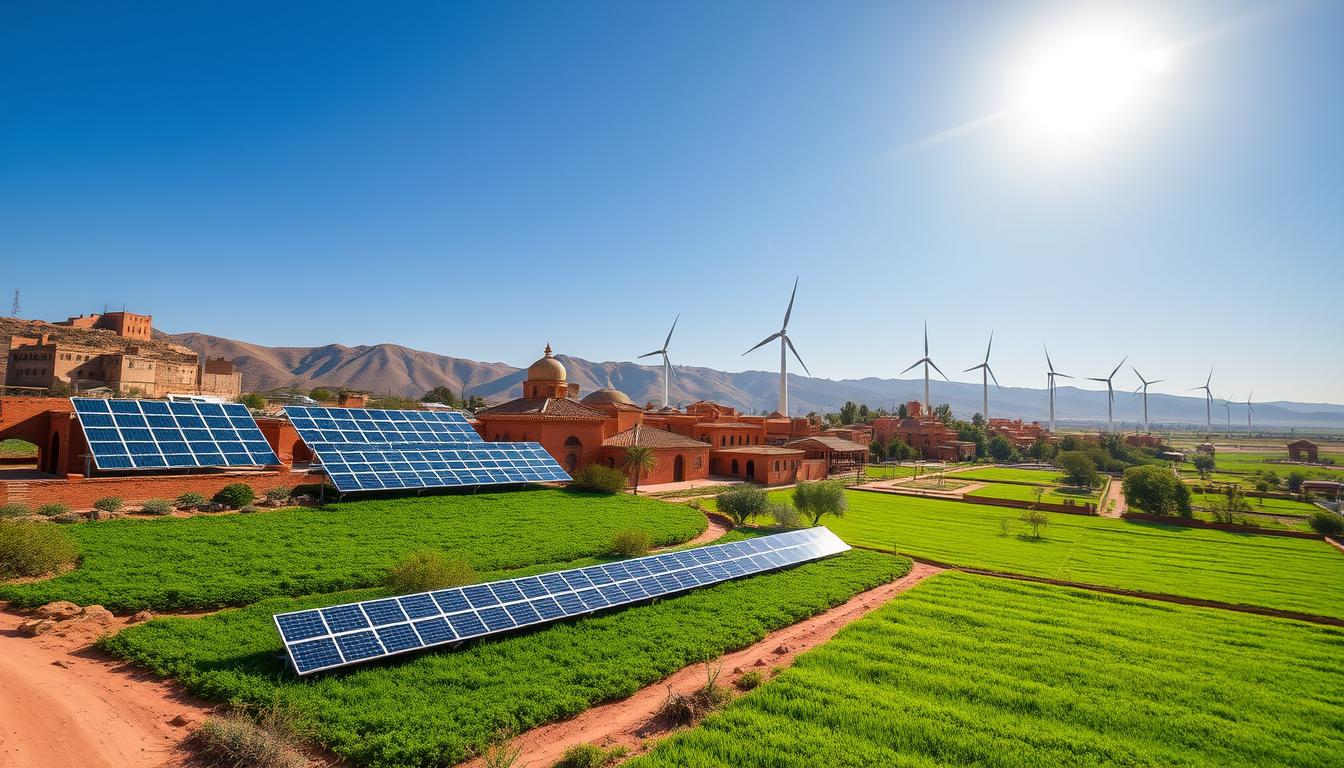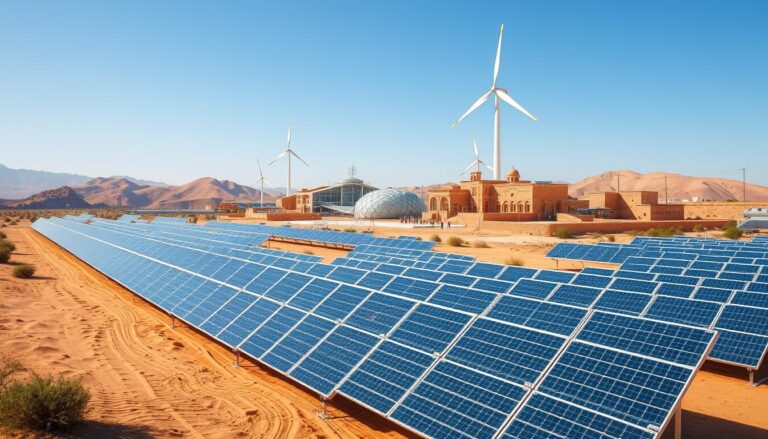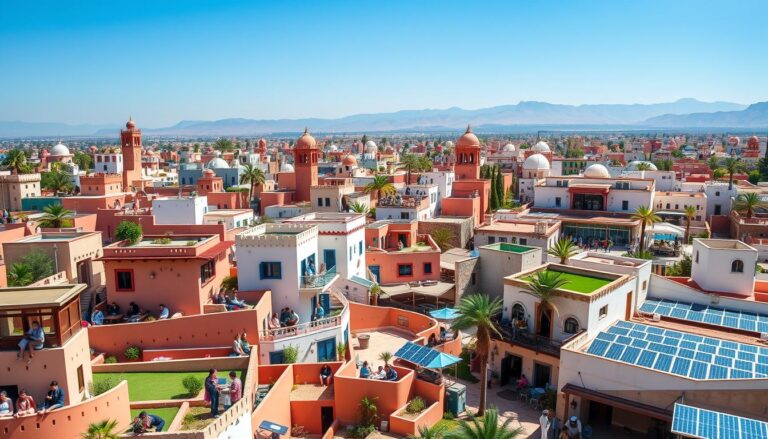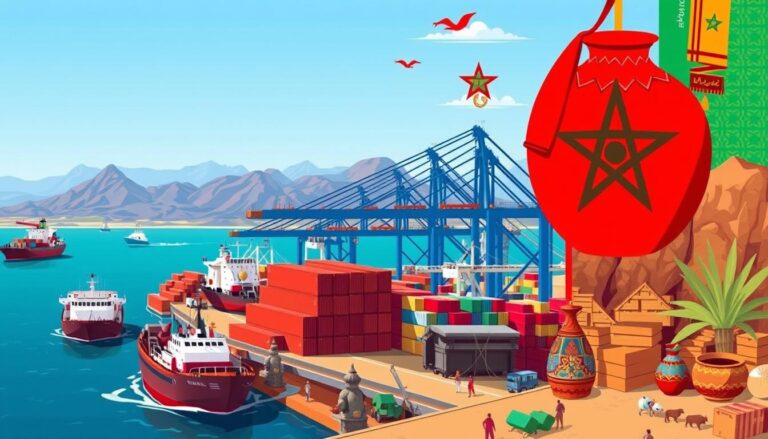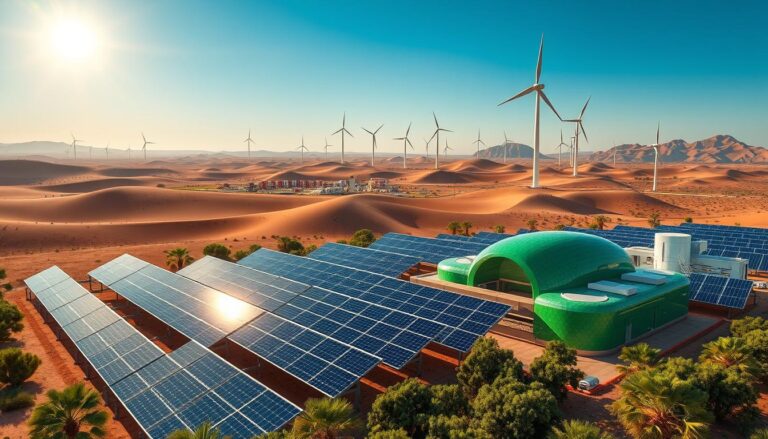How did a nation known for its rich heritage and stunning landscapes become a leader in eco-friendly practices and sustainable growth? Morocco’s journey toward renewable energy and new industrial strategies is key.
Recently, Morocco has shown strong commitment to climate change action. This effort is called Morocco’s Green Industrial Revolution. It’s not just about using sustainable practices. It’s also about making sure these practices support Morocco’s green economy.
King Mohammed VI’s leadership has driven Morocco’s efforts. The country is working on industrial strategies that reduce environmental harm and boost local economies.
Introduction to Morocco’s Eco-Friendly Industrial Practices
Morocco has made a big step towards sustainable economic growth. It has combined its economic plans with a focus on being green. This change is key to Morocco’s industrial goals, which stress the need for eco-friendly methods.
The country is working hard to make its industry cleaner and greener. This effort puts Morocco at the forefront of eco-friendly practices.
Morocco is working in many areas to be more environmentally friendly. The Green Morocco Plan (GMP) started in 2008 shows the country’s commitment. It aims to solve environmental problems, improve farming, and help small farmers.
But, the GMP has had some issues. It has affected small farmers and women in ways that weren’t expected.
Morocco is also tackling climate change. It’s using more renewable energy like wind, solar, and hydro power. This move helps the environment and creates jobs, showing how economic and environmental goals can work together.
Another important part of Morocco’s plans is using Carbon Capture and Sequestration (CCS) technology. CCS helps lower emissions but also uses more fuel. Morocco is pushing for policies like carbon pricing to support green energy.
King Mohammed VI has played a big role in these efforts. He has made sure that taking care of the environment is part of Morocco’s economic plans. Morocco’s focus on green practices is a light for a sustainable future.
Renewable Energy Projects Driving Change
Morocco is leading the way in renewable energy, cutting down on fossil fuels. These efforts fight climate change and boost energy independence.
Solar Power Initiatives
The Noor Ouarzazate complex shows Morocco’s big plans for solar power. It started working in 2018, showing how solar can work even without direct sun. Ten years ago, solar panels were too pricey for many Moroccans. But now, thanks to more investment, solar is cheaper than coal.
Wind Energy Developments
Morocco is also growing in wind energy. It uses its location to build wind farms that work well together. These projects help Morocco use different kinds of renewable energy and keep its energy in its own hands. This makes Morocco a big player in North Africa’s green energy.
Hydroelectric Power Ventures
Morocco is also looking into hydroelectric power. It’s working on projects that use water to make electricity. These efforts help the country’s energy mix and give power to rural areas. They’re key to Morocco’s goal of a green future.
The Rise of Green Mobility: Electric Vehicle Production
Morocco is leading the way in green mobility with big plans for electric cars. It’s close to signing a $2 billion deal for a huge factory to make EV batteries. This factory will be as big as Tesla’s in Shanghai, making 500,000 EV batteries a year. Morocco is using green energy, making it a key player in electric car production.
The country is making great progress in electric car making. It can now make over 700,000 cars a year, aiming for 1 million by 2025. Many of these will be electric, showing Morocco’s dedication to clean cars. The government has also cut taxes on lithium-ion batteries, which are key for EVs.
Morocco has a strong car-making base, which helps its goals. For example, Peugeot’s Kénitra plant can switch to making electric cars. With a focus on green cars and battery making, the shift to EVs is easier.
Morocco’s location and planning are also key. It’s getting stronger in the Western supply chain. It’s using its mineral resources to boost EV production, making it a major player.
Europe wants to stop using fossil fuel cars by 2035. This means more demand for EVs and sustainable cobalt. Morocco is ready to help, supporting the region’s green goals and keeping electric cars flowing.
Investments in Clean Technology Advancements
Morocco is leading the way in clean technology, aiming to be a green tech leader. It’s doing this through big investments in public-private partnerships and global collaborations.
Public-Private Partnerships
The Moroccan government sees public-private partnerships as key to a sustainable future. By 2030, it wants to add 10 gigawatts of renewable energy. This will need over USD 30 billion, with private money playing a big part.
Projects like the Noor Ouarzazate solar complex show this teamwork. It powers nearly two million homes and cuts greenhouse gas emissions by almost one million tons each year.
Global Collaborations
International partnerships are also vital for Morocco’s clean tech progress. The country is working with others to improve its sustainable development. Morocco is a leader in the Climate Vulnerable Forum, aiming for 100% renewable energy by 2050.
Its automotive and aerospace sectors are among the best globally. Morocco is aggressively investing in clean energy, showing its dedication to sustainability. It wants to reduce its energy dependence and boost its industrial ecosystems with new projects.
Green Manufacturing Practices and Industry Growth
Morocco is leading the way in green manufacturing, boosting its industry. This shift to eco-friendly production is key to sustainable growth and economic gains. The manufacturing sector now makes up about 15 percent of Morocco’s GDP.
This shows how vital the sector is in fighting early industrial decline.
“Renewable energy sources currently account for 37 percent of Morocco’s installed electricity generation capacity, with a target to achieve a 52 percent share by 2030.”
Morocco is focusing on sustainable industrialization through eco-industrial parks and clean energy. This commitment to green practices meets the country’s ambitious environmental goals. Between 2010 and 2019, the manufacturing sector’s share of foreign direct investments (FDIs) jumped from 15 to 37 percent.
This shows Morocco’s strategic move towards sustainable industry growth.
The kingdom aims to reduce carbon emissions in key sectors like cement, steel, and fertilizers. This effort has made Morocco a leader in sustainable industrialization in Africa. For example, the Noor Solar Complex shows Morocco’s forward-thinking in renewable energy.
Also, the rise in income per capita from 1998 to 2023 shows the economic benefits of green manufacturing. Improved infrastructure, like the highway network, is also boosting industry growth. This expansion is set to reach 3,000 kilometers by 2030.
As Morocco keeps investing in sustainability, it’s not just leading in eco-friendly production. It’s also showing other countries how to grow their economies while protecting the environment.
Morocco’s Strategic Vision for a Sustainable Future
Morocco, under King Mohammed VI, is dedicated to a sustainable future. It has a clear strategic vision for sustainability. This vision is seen in its policies and plans for development.
Leadership and Policy Initiatives
Morocco leads in environmental policy with a focus on green growth. It has set up the Solar Plan, Wind Plan, Energy Strategy, and Water Strategy. These plans aim to boost energy independence and support sustainable industries.
The results are impressive. Morocco has spent $6 billion on renewable energy, reaching 4GW in 2021. Renewable energy made up 37% of its total capacity in 2020. The goal is to reach 52% by 2030.
National Action Plans
Morocco’s national action plans for climate change show its commitment to the environment. The National Sustainable Development Strategy (NSDS) sets goals for 2015-2020. It aims to build a green and inclusive economy.
- Economic and Financial Instruments: Boosting economic strength and financial tools.
- Sustainable Mobility: Supporting eco-friendly transport.
- Urban Planning Alignment: Making cities more sustainable.
- Natural Resource Management: Better protecting biodiversity.
- Climate Change Policy: Moving fast on climate change policy.
- Human Development and Inequality Reduction: Working for fair social development.
- Sustainable Development Culture: Promoting education and innovation in sustainability.
Morocco is a leader in sustainable development. It ranked 5th globally on the Country Climate Performance Index in 2022. Its strong policies show it’s a forward-thinking nation aiming for a green future.
The Role of Cobalt and Critical Minerals in Morocco
Morocco is leading the way in sustainable mining thanks to its critical minerals. It has a lot of cobalt reserves in Morocco. This makes it key for the global shift to clean energy, especially in making batteries.
The cobalt reserves in Morocco are crucial for electric vehicle batteries. As the world moves towards green cars, Morocco’s importance grows. It uses sustainable mining practices, making it a better choice than some other big producers.
Morocco does more than just provide cobalt for battery production. It’s also a big player in the African car industry, making over 700,000 vehicles a year. This supports local jobs and helps with the global move to electric cars.
Morocco also has other critical minerals besides cobalt. It plans to use these resources wisely. This will make Morocco a major player in sustainable mining. Its focus on ethical mining and less harm to the environment is a good example for others.
But Morocco’s impact goes beyond mining. Its aerospace and pharmaceutical sectors also grow with its car industry. This mix helps Morocco stay competitive and keep growing in a tough global market.
Challenges and Opportunities in Environmental Sustainability
Morocco is tackling environmental challenges with new ideas. The country faces rising temperatures and less rain. Since the 1970s, its average temperature has gone up by almost 1.4 degrees Celsius, more than the global average.
Water scarcity is another big issue. From 1960 to 2020, water per person dropped by 75 percent. A lot of Morocco’s poor live in rural areas, relying on farming. This could lead to 2 million people moving to cities.
Impact of Climate Change
Climate change is a big threat to Morocco’s environment and economy. The country’s farming, which needs water, is at risk. The World Bank says 60 percent of the Middle East and North Africa’s water is shared, making water management harder.
Water Scarcity Solutions
Morocco is building big dams, water treatment plants, and desalination projects. The government aims to irrigate one million hectares by 2030. This will help farming even with water challenges.
Morocco’s efforts to solve environmental problems are inspiring. The country is balancing growth with protecting the environment. By using sustainable methods and smart solutions, Morocco is ready to face climate change and water scarcity.
Morocco’s Green Industrial Revolution
Morocco is going through a big change, making its industry more sustainable. It started with the Emergence Plan from 2005 to 2009. This plan encouraged new investments and created sectors like Morocco’s Global Industries (MGI).
Then, the National Pact for Industrial Emergence from 2009 to 2015 focused on six key areas. These were offshoring, automotive, aerospace, electronics, textiles and leather, and agro-industry.
Morocco is now a top player in the automotive world, ranking third globally. It also leads Africa in the aerospace industry. Thanks to climate policies, the Industrial Acceleration Plan from 2014 to 2020 created over 700,000 jobs.
Renewable energy is key in Morocco’s shift to a greener industry. The Noor Ouarzazate solar complex powers two million people and cuts greenhouse gas emissions by nearly one million tons each year. By 2020, solar and wind energy had grown a lot, aiming for 52% of electricity from renewables by 2030.
Morocco wants to use less energy, aiming for 89% less. It’s investing heavily in green projects. For example, the Noor Laâyoune I plant and the Nador West Med port show its commitment to sustainable growth.
The Tangier Med port complex is a big sign of Morocco’s green transition. Despite tough times, Morocco keeps pushing for renewable energy. It’s reducing coal use for electricity, showing its dedication to both sustainability and growth.
The kingdom’s dedication to balancing economic growth with environmental stewardship has placed it at the forefront of the global green industrial revolution.
Global Recognition and Future Prospects
Morocco has made a big name for itself in sustainable development. It’s known for its push towards renewable energy. This has set a high standard for other countries to follow.
Morocco has invested a lot in clean energy. It has also made big steps in green policies. This puts it at the top of the list when it comes to fighting climate change.
International Acclaim
Morocco’s green efforts have won it praise worldwide. It’s shown through projects like the Ouarzazate solar power plant. These projects show Morocco’s leadership in renewable energy.
Morocco is also a leader in the automotive and aeronautics industries in Africa. This shows it can mix industrial success with green goals. The world sees Morocco as a key player in going green.
Future Goals and Commitments
Morocco has big plans for the future. It wants to get 50% of its energy from renewables by 2030. It’s also working on a new investment charter to boost energy efficiency.
Morocco aims to reduce its greenhouse gas emissions. This shows its dedication to protecting the environment. Morocco is set to keep being a leader in sustainable development.
Conclusion
Morocco is leading the way towards a sustainable future. It has made big steps in being environmentally responsible. This is shown in its focus on renewable energy, green manufacturing, and eco-friendly policies.
These efforts have made Morocco a leader in climate action. It’s not just in the region but globally too.
Morocco’s progress is impressive. It now gets 37 percent of its electricity from renewable sources. It aims to hit 52 percent by 2030.
The country has also become Africa’s top car producer. It’s focusing on electric vehicles, which fits with global green goals. The European Union wants to be fossil fuel-free by 2035.
Morocco’s work has also improved people’s lives. Life expectancy has gone up by nine years. Education and poverty rates have seen big drops.
Now, every rural Moroccan has access to electricity and clean water. This shows Morocco’s commitment to a balanced and sustainable society.
By tackling climate change and managing resources, Morocco is showing the way. It’s inspiring other countries to work towards a greener future.
Source Links
- A shining example of green energy in Morocco
- The Green Industrial Revolution
- Morocco’s path to a climate-resilient energy transition: identifying emission drivers, proposing solutions, and addressing barriers
- The Green Morocco Plan: A Case Study of the Unintended Consequences of Sustainable Development Initiatives
- A shining example of green energy in Morocco
- A shining example of green energy in Morocco
- Morocco’s green mobility revolution: The geo-economic factors driving its rise as an electric vehicle manufacturing hub
- Morocco’s sustainable energy transition and the role of financing costs: a participatory electricity system modeling approach – Energy, Sustainability and Society
- The Industrial Revolution in Morocco under the reign of King Mohammed VI
- Morocco’s Long Road Toward Economic Transformation
- Recent advances in green technology and Industrial Revolution 4.0 for a sustainable future
- Maximising the Green Path to Industrialisation in Africa
- MOROCCO: Visionary goals translate into competitive industries
- Critical Minerals and Routes to Diversification in Africa: Opportunities for Diversification into Renewable Energy Technologies – The Case of Morocco
- Mining in Africa and its role in the global energy transition
- Climate Challenges & Opportunities in Morocco and Beyond
- Morocco in the world’s top 10 in environmental sustainability
- Morocco and the Future of Green Hydrogen
- How Morocco went big on solar energy
- MergedFile
- The energy transition in North Africa | Transnational Institute
- Morocco’s Long Road Toward Economic Transformation
- A Critical Analysis of Morocco’s Green Hydrogen Roadmap: A Modelling Approach to Assess Country Readiness from the Energy Trilemma Perspective

The Editorial Team is a passionate group of Morocco enthusiasts dedicated to sharing the beauty, culture, and wonders of this captivating country. With diverse backgrounds and a deep love for travel, we strive to bring you engaging and informative content that inspires your Moroccan adventures. From uncovering hidden gems and sharing local insights to exploring mouthwatering cuisine and showcasing the vibrant lifestyle, our team is committed to providing you with valuable resources and exciting stories that enhance your exploration of Morocco. Join us on this journey as we celebrate the rich heritage and unforgettable experiences that make Morocco truly special.

